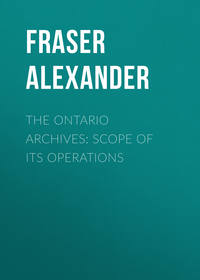Kitobni fayl sifatida yuklab bo'lmaydi, lekin bizning ilovamizda yoki veb-saytda onlayn o'qilishi mumkin.
Kitobni o'qish: «The Ontario Archives: Scope of its Operations»
THE ONTARIO ARCHIVES
By Alexander Fraser, Provincial Archivist
The line of demarcation between the Canadian or Dominion archives and the Ontario or other provincial archives is somewhat similar to that between the Federal and State archives in the United States. It consists with the scope of the jurisdiction of the Dominion or major commonwealth, and the narrower or minor jurisdiction of the Province. This constitutes a clearly defined boundary within which both work without conflict or overlapping of interests. Our public charter is an imperial statute entitled the British North America act, and to-day, when there are nine fully constituted, autonomous Provinces within the Dominion of Canada, it is interesting to recall that when the British North America act became law in 1867 the subtitle set forth that it was "An act for the union of Canada, Nova Scotia, and New Brunswick, and the government thereof; and for purposes connected therewith."
This act provides for the government of Ontario a lieutenant-governor, who represents the Crown; an executive council of ministers of state and a legislature composed of duly elected representatives of the people. To this body the act secures exclusive legislative powers in Ontario and Quebec, in the matter of Crown lands, forests and mines; education, from the public common school to the university; municipal government, institutions and laws; incorporation of chartered companies – commercial, financial, professional, or social; solemnization of marriage, involving family history, vital statistics, etc.; property and civil rights; administration of justice, embracing both civil and criminal jurisdiction; agriculture and immigration, under which municipal, industrial, and agricultural statistics are collected, tabulated, and published; the founding and maintenance of provincial institutions such as hospitals, asylums, reformatories, prisons, and institutions for the instruction of the deaf and dumb and the blind; offices for the local registration of deeds, titles to land; the licensing of shops, taverns, hotels, auctioneers, etc.; the erection of local public works; the authorization and regulation of transportation not interprovincial.
In short the Provincial Government gets close to the life of the people and touches its business and social sides intimately. As at present constituted the ministry comprises the departments of: The attorney general, dealing with the administration of law; the provincial secretary, controlling registration, and the public institutions; the provincial treasurer, dealing with the public accounts; agriculture; lands, forests, and mines; public works; and education. The prime minister is statutorily president of the council and head of the ministry. Besides these and exercising semi-ministerial or departmental functions are two commissions, the hydro-electric commission and the Government railway commission. These, with the legislature itself, are the departments of government in which our archives originate.
Archives we have defined as the records, the business papers, of the province having a permanent value. All archives need not be of historical value in the narrow sense. Public documents may have a business or record value apart from history, yet it would be hard to say that any given document might not be found useful in some way in connection with history. The main value of a document is as an evidence of truth. Every document does not contain truth, yet even such a document may, in effect, be a fact in history, and training and experience lead to a reasonably true interpretation.
The Ontario Bureau of Archives, organized in 1903, is equally related and attached to all the Government departments, and receives all papers and documents of record value or of historical interest, not in current use, from all branches of the public service. When possible, these documents are classified, calendared, and indexed.
The archives originating in the legislative assembly are: The Scroll of Parliament – the documents known by that title being the notes and memoranda made by the clerk, of the routine proceedings of the house during its sessions; the original signatures of the members of the legislative assembly subscribed to the oath of allegiance when "sworn in" as members of the assembly, the signatures being written on parchment; copies of the statutes in the form in which they have been assented to and signed by His Honor the Lieutenant Governor. These copies are printed on good paper, and after having been assented to become the originals of the statutes in force; and the original copy pertaining to the consolidated statutes.
Among the assembly archives are the manuscripts of all sessional papers not printed (a sessional paper is a return called for by order of the house, whether printed or not, and the reports of departments and all branches of the public service presented to the house); the originals of all petitions presented to the house (these are not printed); the originals of bills in the form in which they are presented to the house; and copies of bills amended during their passage through the house. The original copy of sessional papers which are printed is returned with the proof sheets to the department or officer issuing the same.
